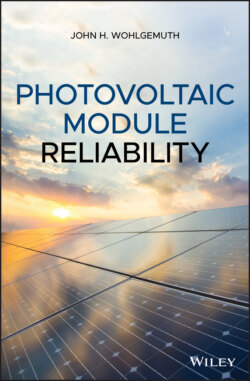Читать книгу Photovoltaic Module Reliability - John H. Wohlgemuth - Страница 2
Table of Contents
Оглавление1 Cover
2 Photovoltaic Module Reliability
3 Acknowledgments
4 1 Introduction 1.1 Brief History of PVs 1.2 Types of PV Cells 1.3 Module Packaging – Purpose and Types 1.4 What Does Reliability Mean for PV Modules? 1.5 Preview of the Book References
5 2 Module Failure Modes 2.1 Broken Interconnects 2.2 Broken/Cracked Cells and Snail Trails 2.3 Delamination 2.4 Corrosion of Cell Metallization 2.5 Encapsulant Discoloration 2.6 Failure of Electrical Bonds Particularly Solder Bonds 2.7 Glass Breakage 2.8 Junction Box Problems 2.9 Loss of Elastomeric Properties of Back Sheets 2.10 Reverse Bias Hot Spots 2.11 By‐Pass Diodes 2.12 Structural Failures 2.13 Ground Faults and Open Circuits Leading to Arcing 2.14 Potential Induced Degradation 2.15 Thin‐Film Specific Defects References
6 3 Development of Accelerated Stress Tests 3.1 Thermal Cycling or Change in Temperature 3.2 Damp Heat 3.3 Humidity Freeze 3.4 Ultraviolet (UV) Light Exposure 3.5 Static Mechanical Load 3.6 Cyclic (Dynamic) Mechanical Load 3.7 Reverse Bias Hot Spot Test 3.8 Bypass Diode Thermal Test 3.9 Hail Test References
7 4 Qualification Testing 4.1 JPL Block Buy Program 4.2 Evolution of IEC 61215 Qualification Test Sequence 4.3 IEC 61215 Test Protocol 4.4 How Qualification Tests have been Critical to Improving the Reliability and Durability of PV Modules 4.5 Limitations of the Qualification Tests 4.6 PV Module Safety Certification References
8 5 Failure Analysis Tools 5.1 PV Performance – Analysis of Light I–V Curves 5.2 Performance as a Function of Irradiance 5.3 Dark I–V Curves 5.4 Visual Inspection 5.5 Infrared (IR) Inspection 5.6 Electroluminescence (EL) 5.7 Adhesion of Layers, Boxes, Frames, etc. References
9 6 Using Quality Management Systems to Manufacture PV Modules 6.1 Quality Management Systems 6.2 Using ISO 9000 and IEC 61215 6.3 Why just Using IEC 61215 and ISO 9000 is No Longer Considered Adequate? 6.4 Customer Defined “Do It Yourself” Quality Management and Qualification Systems (IEC 61215 on Steroids) 6.5 Problems with the “Do It Yourself” System References
10 7 The PVQAT Effort 7.1 Task Group 1: PV QA Guidelines for Module Manufacturing 7.2 Task Group 2: Testing for Thermal and Mechanical Fatigue 7.3 Task Group 3: Testing for Humidity, Temperature and Voltage 7.4 Task Group 4: Testing for Diodes, Shading and Reverse Bias 7.5 Task Group 5: Testing for UV, Temperature and Humidity 7.6 Task Group 6: Communications of Rating Information 7.7 Task Group 7: Testing for Snow and Wind Load 7.8 Task Group 8: Testing for Thin‐Film Modules 7.9 Task Group 9: Testing for Concentrator Photovoltaic (CPV) 7.10 Task Group 10: Testing for Connectors 7.11 Task Group 11: QA for PV Systems 7.12 Task Group 12: Soiling and Dust 7.13 Task Group 13: Cells References
11 8 Conformity Assessment and IECRE 8.1 Module Conformity Assessment – PowerMark, IECQ, PVGAP, and IECEE 8.2 IECRE – Conformity Assessment for PV Systems References
12 9 Predicting PV Module Service Life 9.1 Determining Acceleration Factors 9.2 Impact of Design and Manufacturing on Failure or Degradation Rates for PV Modules 9.3 Impact of Location and Type of Mounting on Failure or Degradation Rates for PV Modules 9.4 Extended Stress Testing of PV Modules 9.5 Setting Up a True Service Life Prediction Program References
13 10 What does the Future Hold for PV and a Brief Summary 10.1 Current Work on Updating Standards 10.2 Looking to the Future 10.3 Brief Summary References
14 Index
15 End User License Agreement
